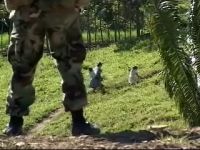
The issue of the Special Agreement and referendum it promises has taken
center stage nationally but there’s a significant dvelopment on the ground
that is a far more immediate concern. There is a significant structural incursion
into Belizean territory near the south western village of Jalacte. It is a development
authorities on both sides of the border and at the OAS are aware of but it seems
to have been something they were powerless to halt. This weekend Jules Vasquez
and Alex Ellis went into extreme south western Belize to investigate.
Jules Vasquez Reporting,
These horses are saddled with two hundred pounds of corn each. These farmers
and his sons will walk them about ten rugged miles from Santa Elena Village
to Jalacte Village. It will take them 5 hours – and they started at dawn 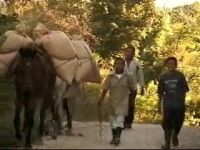 in the golden light and 60 degree chill of an early December morning.
in the golden light and 60 degree chill of an early December morning.
Jalacte is the end of the line – a village on Belize’s most southwestern
border and a lively trading point between Belize and Guatemala. The Mayans of
these Belizean take their corn from Jalacte into Santa Cruz, the nearest village
in Guatemala; it is about a mile and a half away. Here, traders are fastening
their bags snugly to horses and donkeys for the difficult trek into Guatemala.
Jules Vasquez,
How much for each bag of corn?
Pedro Kus, Farmer
“78 quetzals.”
Jules Vasquez,
That’s about 25 Belize dollars.
Pedro Kus,
“Yeah.”
25 Belize dollars per sack for a lengthy, difficult journey – involving
hours of man labour not least of which is this – the shelling of the husks
of dried corn – a back breaking manual process that takes hours. And these
farmers saved a few hours; they hitched a ride in our pickup truck and here 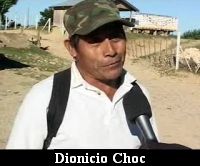 in Jalacte transferred their hundred pound sacks to horseback because there
is no road into Santa Cruz. Still road or not, dozens of sacks of mostly corn
go across daily.
in Jalacte transferred their hundred pound sacks to horseback because there
is no road into Santa Cruz. Still road or not, dozens of sacks of mostly corn
go across daily.
Dionicio Choc,
“The reason why people bring their corn here is because there is no
market in Belize. For that reason, the people have to come all the way to Guatemala
to sell their product.”
Jules Vasquez,
And the Guatemalans are eager to buy it?
Dionicio Choc,
“Yeah if you bring 100 bags they will buy it but in PG if a poor farmer
takes his corn there, 5 bags, it would take the whole day to sell the corn there
but Guatemala is a place where they buy corn.”
And they buy plenty of it. So the farmers have to trek across from Jalacte
to Santa Cruz, the nearest village in Guatemala. It is an arduous journey across
these last few miles, up and down hills and narrow, muddy hoof-pocked trails
and across the Aguacate Creek. The landscape is often broad and breath-taking
but the terrain is rough, and by the end of it I was exhausted.
We were met the by BDF soldiers who just happened to be patrolling the area.
The road you see them walking on lined by Madre Cacao trees is what’s 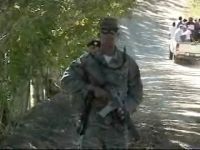 commonly considered the borderline between Belize and Guatemala though it is
not formally demarcated. And the road beside it, is considered Guatemalan. But
according to GPS coordinates, that would be wrong; the road built a few years
ago is on Belizean territory though the Guatemalans built it. For these reasons
and many more, the BDF are on very high alert when they are in this area.
commonly considered the borderline between Belize and Guatemala though it is
not formally demarcated. And the road beside it, is considered Guatemalan. But
according to GPS coordinates, that would be wrong; the road built a few years
ago is on Belizean territory though the Guatemalans built it. For these reasons
and many more, the BDF are on very high alert when they are in this area.
Corporal Tasher of the BDF,
“As every soldiers knows that once you are on the borderline, they
are risking their life because it is not only the soldiers that we are interacting
with, it is also the civilians from Guatemala so on a day to day basis we are
risking our lives.”
Jules Vasquez,
How do the Guatemalans respond to your presence in the area?
Corporal Tasher of the BDF,
“Well sometimes they accept us and sometimes when things get hot on
the border, reference to other things when they know they are doing wrong, then
they try to retaliate on us.”
And things are hot right now because of this buildup on top of a hill which
looks directly across to Jalacte. It is the highest point on a Guatemalan owned
cattle ranch which is in Belize – we’re told it’s the property
of Leonel Arrelanos, a powerful local businessman in Santa Cruz. One month ago, 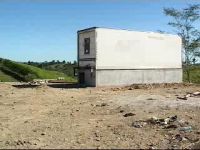 he started to build in an area clearly within Belizean territory. The BDF who
patrol the area sent official notices of the incursion to their higher-ups in
Belize, but nothing was done to stop the works.
he started to build in an area clearly within Belizean territory. The BDF who
patrol the area sent official notices of the incursion to their higher-ups in
Belize, but nothing was done to stop the works.
Wil Maheia a third party activist with the PNP and our guide for the day also
sent warnings.
Wil Maheia, PNP
“About a month ago, just before the 19th of November, I remember we
came out here, sent pictures to the press, showed them where bulldozers have
made a road coming into Belize and yet nothing has been done. If we Belizeans
would do the same, go over there into Guatemala – we would have been thrown
out.”
But Arrellanos was left to build and one month later he has a concrete base,
with a container perched atop it – upon a large prominently placed, well
bulldozed mound. No one knows what’s in the container, but the placement
at the top of a prominent hill facing towards East makes it seem almost like
a direct affront to Belize’s sovereignty.
Information in the area says it will be some sort of hardware store, but no
one knows really; all the BDF know is that this hill and the structure are in
Belizean territory but the owner who lives just down the road carries a gun
and says the clearing is on his property in Guatemala.
And that’s where it gets complex because the road leading from the mound
on the hilltop into Santa Cruz town is widely considered to be Guatemalan territory
– in fact it’s the Guatemalans who put down the road years ago,
carried a gun, and it is used by Guatemalan taxis such as this one owned by
Erwin Rene Martinez who is clear that he is in Guatemala.
Jules Vasquez,
Where are we?
Erwin Rene Martinez, Guatemalan Taxi Driver
“Supposedly they say this is a street in Guatemala.”
Jules Vasquez,
Suppose I say we are in Belize?
Erwin Rene Martinez,
“It is possible.”
Jules Vasquez,
If the Belizean officials were to tell you that this is a road in Belize what
would you do?
Erwin Rene Martinez,
“If it’s for Belize, it’s for Belize. If it’s for
Belize, there is no problem. We have to be reasonable.”
Edgar Savedra also is also reasonable, he’s lived in Jalacte for 20 years
but is Guatemalan.
Edgar Savedra, Jalacte Resident
“I was born in Guatemala but I have to live in Belize because I need 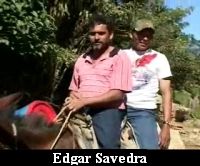 somewhere to work. In Guatemala there are only pasturelands and poor people
like myself have nowhere to love.
somewhere to work. In Guatemala there are only pasturelands and poor people
like myself have nowhere to love.
I have more opportunities here in Belize because I like to make milpas.
I can plant beans and rice and I need to work. In my country I don’t have
an opportunity to work because I don’t have any land.”
And that brings into sharp focus the central issue between these neighboring
countries; Belize has an abundance of land and opportunity; Guatemala has an 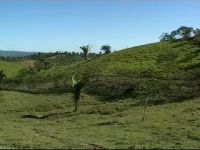 abundance of people who need both and can’t find it in their own country.
abundance of people who need both and can’t find it in their own country.
Which brings us back to corn – the currency that maintains the relationship
between these border villages. The corn grown upon Belize’s abundant lands
comes here to this bodega as they call it. And guess who owns the bodega? Leonel
Arellanos, the same man who’s built the offending structure within Belizean
territory.
His son Ferdie who spends his weekends helping out at the corn shed goes to
school in Punta Gorda:
Jules Vasquez,
So you go to school in PG?
Ferdie Arellanos TCC student
“Yes sir.”
Jules Vasquez,
Which school?
Ferdie Arellanos,
“TCC.”
Jules Vasquez,
Why?
Ferdie Arellanos,
“Because I want to learn 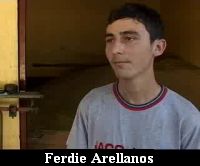 English.”
English.”
Jules Vasquez,
But you live here in Guatemala?
Ferdie Arellanos,
“Yes sir.”
Jules Vasquez,
But where do you see your future?
Ferdie Arellanos,
“Belize. I see the future there.”
His little brother goes to school in Jalacte
Jules Vasquez,
Do they have school here in Santa Cruz?
Ferdie’s Brother,
“Yes they have.”
Jules Vasquez,
Why do you then go to school in Jalacte?
Ferdie’s Brother,
“Because I want to learn English.”
Jules Vasquez,
What’s the advantage in knowing English?
Ferdie’s Brother,
“The advantage in learning English is that most Belizean come to Guatemala
and if we don’t learn English, how will we understand ourselves.”
And apparently, they understand fine right now, because Belize’s Mayan
farmers are paid in quetzals –most of which is spent right here on the
village on cheap groceries like these that we saw Dionicio Choc taking back 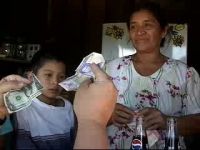 into Jaclacte. Santa Cruz Guatemala is a quite a bustling center of commerce
– and one of the only places in the world where they prefer Belize dollars
over US dollars.
into Jaclacte. Santa Cruz Guatemala is a quite a bustling center of commerce
– and one of the only places in the world where they prefer Belize dollars
over US dollars.
[Shopkeeper indicating preference for Belize $2 note over US$1 bill.]
Unlike Jalacte, it has electricity and Belizean shoppers come here for Gallo
beers, and cheap products. The village – or most of it – is in Guatemalan
territory – the cemetery for example is believed to be inside Belizean
territory. But it’s a fine, widely unknown line, and the entire village
exists under the eye of the BDF treetops observation post – the sole indicator
of Belize’s domain in the area.
It is ground they are holding in hostile territory, the Guatemalans resent
the military’s presence, and after taping for few minutes it was made
clear to us by a group of village leaders that our presence was also not welcome.
Back in Jalacte and after recovering from the grueling trek back under the
midday sun, I considered this village, a small trading outpost, its jarring
juxtapositions between of Guatemalan and Belizean branding, the commanding Guatemalan
phone tower on the borderline, the fact that my phone had switched over from
Telemedia to service from the Guatemalan phone company TIGO, which is the only
phone service this and surrounding villages get – where by the way, they
offer triple-up, not double up as we found out when this young Jalacte woman
was putting in credits for her Guatemalan phone.
And moving as freely as phone signals, everyday the BDF looks on as scores
of Belizeans and Guatemalans go back and forth between Jalacte and Santa Cruz.
Their job is to hold the line – a line not marked in any way, a line whose
true location is known only to technicians who use GPS devices, a line that
is a good few hundred feet west of, behind this structure. It is either a matter
for grave concern, or earnest hope.
Edgar Savedra,
"We live as a community in friendship. That is why we don’t have
any problems, we live in peace.”
Wil Maheia,
“Every year Belize gets smaller and smaller because the road that
we just came on, that is clearly inside Belizean territory and the people living
there are Guatemalans. They think they are living inside of Guatemala, yet they
are living on Belizean territory.”
Ferdie’s Brother,
“Belizeans with Guatemala, we are friendship. We and Belize, we are
friends but I don’t know what the people think and someday we argue with
Belize but I don’t know why. I just only want to ask that question, I
want to ask somebody: why they noh come friends.”
And how the technicians, politicians and diplomats deal with this illegal encroachment
will largely determine what happens at the official level – but at the
ground level, we suspect the free movement and informal trade will continue
because these are neighbors and no policy or referendum can dictate their co-existence.
A few significant notes. First about the illegal structure, the Ministry
of Foreign Affairs tells us that they expect that it will be removed by Thursday
or Friday of this week. They have been discussing this with the OAS, and though
the BDF is expected to remove it, they will do so with oversight from the OAS.
And the second note: while corn is one thing, sources tell us that
smuggling cattle from Belize to Guatemala is far more significant and a far
greater threat because there’s much more money involved. Sources with
knowledge of the area tell us it’s the illicit cattle trade which is driving
and has driven development in Santa Cruz and along the border line. Indeed,
we saw quite a few cattle trucks empty in the daytime –shuttling around
the area and one of them with Guatemalan plates was parked in Jalacte.



